This article has previously appeared on the ADLIB Blog.
In this Women In Design feature, we caught up with Vee Rogacheva, Head of Product Design at Go.Compare which is part of Future Plc.
Vee emphasizes the importance of empathy, accessibility, and diversity in her work. She also highlights the unique contributions women bring to design, the need for mentorship, and the importance of owning your career to unlock opportunities for growth and success.
Could you please introduce yourself as well as your background?
Hi, I’m Vee Rogacheva, and I’m the Head of Product Design at Go.Compare which is part of Future Plc. I lead a team focused on building experiences that help millions of people across the UK save money.
Go.Compare is a regulated business and the design team is responsible for helping users achieve their financial goals. Our solutions are informed by deep understanding of users, grounded in research, and from the synergy between cross-functional teams and experts.

Before joining Go.Compare, I worked in the Education Technology sector, where I gained valuable insights into creating impactful experiences for users from different parts of the world. Prior to that, I was a user-centered design consultant, working with clients such as The Samaritans, Drinkaware, and Guide Dogs. These experiences helped me develop a deep appreciation for designing with empathy and purpose, focusing on accessibility and the diverse needs of different user groups.
At Go.Compare, I’m passionate about creating solutions that have a real impact on people’s lives, while nurturing a team culture that values creativity, inclusivity, and continuous learning.
In your opinion, what unique perspectives or contributions do you think women bring to the design industry?
As women we often have to challenge stereotypes and bring diversity into design thinking itself. By being in leadership positions, we can also influence the way products are shaped—ensuring that design is not just for a single type of user, but for a wide array of individuals with different backgrounds, needs, and expectations. This results in products that resonate more deeply with a broader audience, fostering inclusivity.

Women are also in a unique position as they, willingly or not, serve as role models for other women in any industry and design is no different. That means that female designers are often expected to not only perform at the highest level but also represent and pave the way for others. This dual role can bring added pressure and can be very tiring, no wonder so many women quit.
I’m passionate about unlocking opportunities in design for other women, which is why I got involved in co-organizing Ladies that UX Bristol, a community that supports women and under-represented genders on their design journey. We get together once a month and it’s a great opportunity to network and learn.
In an attempt to capture some of the Wisdom you’ve gained as a woman in the design sector so far, what is the 1 thing that you’d like to pass on to your peers as well as the future generation of talent within your sector?
I can’t emphasise enough the importance of owning your career. It’s crucial to proactively seek out opportunities for growth. A great example of is the story of my team member, Monica. She previously worked in another team here at Future and reached out to me, expressing her interest in design and her desire to transition from marketing to a UX role. Her initiative not only showcased her passion but also opened the door for her to explore new possibilities in her career. She has been a great addition to the team, bringing in all those skills she already had and quickly gaining new ones as she is now taking on bigger and bigger projects.
If anyone reading this is thinking about reaching out, I can’t promise you a job but I’ll always find time for people looking to break into design or wanting to become better designers. It’s essential to reach out, seek advice, and gather insights from those who can help you navigate your journey. Connecting with peers and mentors helps build your confidence and unlocks valuable opportunities to craft a fulfilling career in design.
If you’re inspired by the stories and wisdom shared in our ‘Women In Design’ series and would like to contribute your own experiences, we’d love to hear from you. Creatives at all levels, please email us and your story could be the next we feature.
Gold: Best Expression of a Brand on Social Media Channels
Bronze: Best Use of Copy Style or Tone of Voice
The Transform Awards celebrate excellence in brand strategy and execution across Europe. saintnicks’ work with Ascot Racecourse brought to life the brand’s creative platform, Elegance at Play – combining social-first storytelling, a distinct tone of voice, and thumb-stopping, jaw-dropping content that captured the attention of both loyal racegoers and new audiences alike.
Speaking on the win, Fraser Bradshaw, CEO at saintnicks, said:
“We set out to create a truly ownable brand voice and world-class social content that matched Ascot’s stature as an iconic British institution. To see that work recognised is a brilliant moment for the team and a testament to the power of brave, collaborative thinking.”
If you’re after a creative brand agency that will go the extra mile for your brand, drop saintnicks a line. You can find out more about their brand, campaigns, content and digital expertise here, or reach out to their Client Services Director, Francois d’Espagnac.
We recently hosted the AHT (Association of Hairdressers and Therapists) Regional Competition for the South West! Students came from across the region including City of Bristol College and Bath College as well as our own students from UCW and Weston College. Higher Education competitors were able to show off their skill in makeup and materials in the ‘Create an Injury’ competition. The learners showed skill in carefully crafting their injury and then blending the injury with the surrounding skin to finish the contest.
Also going on during the day was the Editorial Competition. This tasked learners with creating and executing a makeup look which would suit Vogue Magazine! Following the brief and executing the look to the highest standard possible was essential. Competitors were also able to showcase their creativity through the art of body painting.
Makeup skills were tested throughout the day with the Glam Drag, Facepainting and Theatrical Aging competitions. An exciting competition in the afternoon challenged competitors to create an image based on Moulin Rouge! This was a team challenge, where each member of a team had a set amount of time to do their bit of the makeup and then this would be carried on by their teammate. This helped to build communication and teamwork skills.
Hair, Makeup and Prosthetics for Production lecturer Tara said: “The students from BA Hons Hair, Makeup, and Prosthetics for Production course have showcased incredible talent in the AHT competitions, winning first, second, and third places across categories such as injury simulation, editorial glam, glamorous drag, facepainting and bridal makeup Their creativity and technical skills have earned them gold medals and a place in the finals in Blackpool this May. This is a fantastic opportunity for them to compete at a national level, gain industry recognition, and build confidence in their abilities. We’re incredibly proud of their achievements so far and excited to see them take on the best in the UK!”
Head of Service Sectors Jenna said: “We’re incredibly grateful to our sponsor VTCT who helped to make this event possible. Thanks must also go to the fantastic judges who lent their expertise! Competitions like these have a fantastic impact on our students, giving them the chance to push their limits and show off the skills that they’ve learned.”
This competition forms part of the Performance and Production Arts Careers Excellence Hub. University Centre Weston has eleven sector-specific Career Excellence Hubs, which evidence our dedication to supporting both employers and learners in achieving their future goals. By creating a seamless connection between industry and education, we enable learners to acquire not only the essential skills and knowledge but also the professional networks necessary to excel in their chosen fields.
A huge congratulations to the UCW learners who won medals! You can find a list of them below:
Create an Injury
Glamourous Drag
Bodypainting
Feminine Bridal Makeup
Editorial Makeup
Facepainting ‘Carnival’
Being part of the Bristol Creatives community let’s explore how Business Leaders and HR can build a future-proof benefits strategy to stand out in the crowd.
In 2025, Business Leaders and HR Teams face a perfect storm of rising costs, shifting employee expectations, and global complexities. More than ever, benefits are a critical lever for your company’s success. Looking through the latest research alongside my day-to-day experiences I am witnessing some of the key trends that are reshaping the benefits landscape. It’s these insights that can help build a benefits package that really sticks the landing in 2025.
Trend 1: Low Employee Engagement
Despite many companies identifying employee engagement as their top priority in 2024, only a handful truly offered full flexibility in their benefits packages along with disjointed platforms further exacerbating this issue. Employees still struggle to find what they really need, reducing the perceived value of their benefits.
Companies can boost engagement by implementing flexibly of benefits and improving communication. Flexible allowances empower employees to spend on the benefits that matter most to them, while regular touchpoints ensure that they know what benefits are available to them.
But there’s another challenge. Most organisations don’t even have the data they need to make improvements. Without clear metrics, Business Leaders and HR teams are left guessing at what’s working and what’s not, making it harder to optimise benefits for engagement and retention.
If large enough (if you know…you’ll know!), employers should consider implementing a centralised benefits platform to simplify access and improve communication. Companies should also track key engagement metrics like utilisation rates and employee satisfaction to ensure their benefits are making an impact.
Trend 2: Reprioritising Foundational “Core” Benefits
In 2024, organisations reallocated their budgets to prioritise foundational (or Core) benefits such as medical and life insurance. This shift was largely driven by soaring healthcare costs and NHS waiting lists.
But focusing solely on reactive interventions without addressing preventative measures risks perpetuating the cycle of rising costs and declining health outcomes.
Companies should hold off on completely cutting wellbeing spend and instead pair foundational benefits with preventative wellness initiatives. Low-cost strategies like workplace wellness programs, ergonomic assessments, and access to digital wellbeing tools can reduce long-term healthcare expenses while boosting employee satisfaction. Just ask fellow member Nairn Robertson of Active Teams fame!
With employer healthcare costs reportedly increasing by up to 150% in some regions, benefits leaders are under growing pressure to rethink their approach. More organisations are shifting toward hybrid models that combine traditional insurance with preventative care, such as epigenetic testing, mental health support, and lifestyle coaching. Taking a proactive stance on employee health isn’t just a nice-to-have—it’s a necessity.
Trend 3: The ESG Opportunity
Despite dominating much of the conversation in previous years, Environmental, Social, and Governance (ESG) considerations remain underrepresented in benefits strategies. While initiatives like electric vehicle schemes are gaining traction, the broader social aspects of ESG—such as inclusivity and equity—are often overlooked.
But the winds are due to change. Generation Z highly value sustainability and inclusivity. Organisations that fail to align their benefits with these principles risk losing talent to competitors who demonstrate stronger commitments. Flexible bank holidays, DEI-focused initiatives, and sustainable benefits can enhance your employer brand and meet the expectations of a values-driven workforce.
Companies that integrate social responsibility into their benefits—whether through inclusive healthcare policies, sustainable investment options, or support for underrepresented groups—will gain a significant competitive edge. Employers should go beyond surface-level ESG efforts and embed these principles into their benefits programs.
So, what is the future of benefits? It’s clear…evolve and adapt or risk falling from behind. The data is clear: Business Leaders and HR who take a proactive, data-driven approach will lead the way in 2025. Flexibility, innovative tech, and ESG-aligned benefits aren’t just trends—they’re the new standard for a competitive, future-proof benefits strategy. Companies that embrace this shift will build stronger, more engaged workforces, while those that stick to outdated benefits risk losing top talent. The good news? With the right tools and insights, you can take control of your benefits strategy and turn it into a true driver of success.
If you wish to explore these themes further, then drop me a line!
The diligent amongst you may have noticed that recently an AMBITIOUS TikTok hit a million views. If you were part of that viewership, then thank you!
If not, then before you continue reading this. Stop.
Load up TikTok and take a watch… are you done?
Welcome back.
In this blog, we’ll explore the tactics behind getting more views on TikTok, try to break down and explain the TikTok algorithm, lay down some advice on creating engaging content, and emphasize the importance of producing high-quality videos.
But we’ll also tell you why you shouldn’t just go chasing views! There’s so much more to your content strategy than views and views alone.
A view on TikTok is counted the moment a user starts playing your video. This includes replays and views from both your followers and non-followers. However, keep in mind that watching your own video does not count as a view.
The TikTok algorithm is designed to prioritize engaging content that keeps viewers hooked until the end. Even if a user only stays on your video for a second, it will still count as a view. So, focus on creating concise and engaging content that captures attention right from the outset.
If you want to know how to get more views on TikTok, there is one thing you have to have firmly set in your mind first.
There are going to be videos that fail.
Viral videos are few and far between. But the more videos you create and put out into the world, the more chance you have that they will start to fly. It’s really important to not be disheartened, we know how it can be, time and effort for little to no perceived result can be demotivating.
But the reality is, that TikTok is a particularly inconsistent social media platform. One piece of content on one specific day might sink like a stone. But if you post it 6 months later, you could end up with a quarter million views.
TikTok users regularly bemoan this lack of consistency in viewer figures. It can make it very hard to predict exactly what will perform well. In truth, there is no silver bullet as to how to get more views on TikTok.
So if you want to get more views on TikTok, creating content consistently is key. Additionally, consider responding to TikTok comments with a new TikTok video to drive traffic between videos and boost engagement.
TikTok is a strange place and TikTok views equate more to what’s trending at any given moment in time.
To capitalise on this, create videos that respond to questions from TikTok comments, enhancing engagement and views. That could be a cap-cut of a cat on a witches broom, mini-mic interviews or any manner of oddity.
From trending sounds and popular audio clips to TikTok Challenges and everything in between. Rule number one in your TikTok Strategy; if you want to create viral videos and make the most out of TikTok, then you’re going to want to lean into these kinds of viral TikTok trends.
Once you’ve accepted and leant into the strange inconsistencies that TikTok can throw up, the next thing you need to do is adopt a mentality of testing and learning.
Be experimental with your TikTok account and try different things. If something doesn’t work right there and then, that doesn’t mean it never will. You can also come back to that idea, or particular piece of content at a later date.
But always keep trying new things and focus on creating quality content.
So, how can you create great video content?
On TikTok you have mere seconds to make an impact. So your TikTok videos need to get straight to the point. Focus on creating videos that grab people and keep them engaged. Short, high-energy content with a clear story arc tends to perform best.
TikTok’s algorithm loves content that’s on trend. Whether that’s emerging challenges, sounds and hashtags. By incorporating these into content you can see massive increases in views and engagement.
But remember, it’s not just about jumping on trends for the sake of jumping on trends. You need to make sure that when you’re creating on-trend content, you aren’t doing so at the demise of your own brand voice and message.
Hashtags are the key to discoverability on TikTok.
Our content strategists research and select a mix of trending and niche-specific hashtags for each post. We’ve also found that using popular sounds can increase a video’s reach. Our approach is to create a blend of trending audio and branded messaging to get the most impact.
Building a TikTok following isn’t just about posting great content – it’s about creating a community.
We encourage our clients to respond to comments, join the conversation and even feature user-generated content. This level of engagement not only increases visibility but also builds brand loyalty and authenticity.
Responding to comments with a new TikTok video can drive traffic between videos and further enhance visibility and potential reach.
In our experience, consistency is key to TikTok’s success. We work with our clients to create content calendars that ensure regular and timely posts. This consistency tells the algorithm you’re an active and reliable creator which can lead to your content being promoted.
You can take a data-led approach, with a strong emphasis on TikTok analytics. Monitoring performance metrics for each post will help you understand and refine your content strategies moving forward.
TikTok success is a mix of creativity, strategy and adaptability.
As a PR and content specialist, we’ve seen firsthand how these tactics can turn a brand’s TikTok presence from invisible to unmissable.
Getting to a million TikTok views may not be immediately straightforward, but that doesn’t mean it’s impossible. If you want to bring up your view count while making great short videos for your target audience, then you can follow the tips and strategies outlined above to help you along the way.
But the key to making the most out of your TikTok is to not go arbitrarily chasing views.
Chasing vanity metrics like views is an old-fashioned strategy like trying to put AVE onto PR coverage.
What you need to do is measure the impact your content is having. For example, every time you post a ‘day in the life’ video from one of your employees, you might see a spike in job applications – that kind of impact.
We’re not saying never look at views. You should do that.
But you should be looking at engagement, comments and sentiment. These are the markers that tell you your content has quality, relevance and meaning more so than views.
To make TikTok work for you, you need to strike the perfect balance between what’s trending and what’s right for you. By following these strategies, you’re not just chasing views; you’re building a robust engaged community that can impact your overall brand presence.
Access Creative College has launched the Bristol Academy of Visual Arts (AVA), which will provide students with an all-encompassing experience of working within the creative industries alongside their studies.
The Bristol college, which also offers courses in music, gaming, esports and computing, is developing its media pathways by enrolling students into the new Academy to develop core work-ready skills while studying content creation, film, video, photography, animation, visual effects or graphic design.
The Academy will be based at Access Creative College’s Bristol Campus in Broadmead, offering learners access to industry-grade photography studios, green screen rooms, performance spaces and production pods alongside collaborative workspaces.
The College is now calling on businesses and organisations in the creative industries to join as collaborators with the Academy. Learners have already begun exploring work with existing organisations including Sons of Graham and Mobile Pie, as well as local music festivals.
Academy members will also collaborate with the wider college community to capture content and bring to life the incredible work that students produce on a day by day basis. Becoming a collaborator enables organisations to help shape the college’s curriculum and training, and the professional development of learners, offering guidance to young talent to help them meet organisational needs.
The launch of the Bristol Academy of Visual Arts follows feedback from the West of England Local Skills Improvement Plan, which demonstrated that despite Bristol’s thriving creative industry, many parents lack the understanding of creative employment opportunities across the region.
Jon Domaille, Head of Bristol Campus commented: “Bristol is famous across the world for its creative industry, with the likes of the BBC, Aardman and Plimsoll Productions calling the city home. As the largest independent training provider in the UK, we recognise the role we play in supporting the next generation of talent to excel in their creative fields.
“We’re extremely excited to launch the Academy. The unique opportunity to work on live briefs will not only develop the students’ core skills of communication, problem solving and organisational skills that are sought after by employers both regionally and nationally but will also show them first-hand what a career in the creative industries can look like.”
In addition to earning their Level 2 and/or Level 3 Diplomas in their chosen subject matter, learners will be tasked with forming their own limited production companies – developing their own brands, and service offerings based on skill sets, such as graphic design, content creation, film, photography and animation.
Throughout the academic year, students will then have the opportunity to pitch for and work on live projects set by local businesses across the city, working together to fulfil the briefs while developing their skills in teamwork, collaboration and client relations.
Alongside the live briefs, students will also have access to some of the brightest creative minds from across the region, as well as access to workshops with industry practitioners, and trips and experiences to consolidate, inspire and build upon their learned experiences.
Domaille continued: “Inspiring students through opportunity is at the heart of Access Creative College’s ethos, and through the Academy we’re delighted to offer our students access to some of the top creatives our region has to offer. We’re always keen to expand our network and encourage any business that would like to support the Academy and help us shape the talent pipelines of tomorrow to get in contact.”
To find out more or sign up as a partner or collaborator to the Academy, please contact Jon Domaille on email at [email protected]. For more information about the AVA visit: https://www.accesscreative.ac.uk/campaign/bristol-academy-of-visual-arts-ava/
Bristol Light Festival is back! The fifth iteration of the annual event began on Friday 31st January and will run until Sunday 9th February, with 10 installations brightening up the city at a traditionally dark time of the year.
Bristol Light Festival’s digital programme is now available to view here.
The festival covers much of the city centre, with artworks located in the Harbourside, Broadmead, College Green, St Mary Redcliffe Gardens and beyond…
College Green has become home to a flock of bright and beautiful flamingos, delighting visitors with a whimsical display of nature’s most flamboyant creatures.
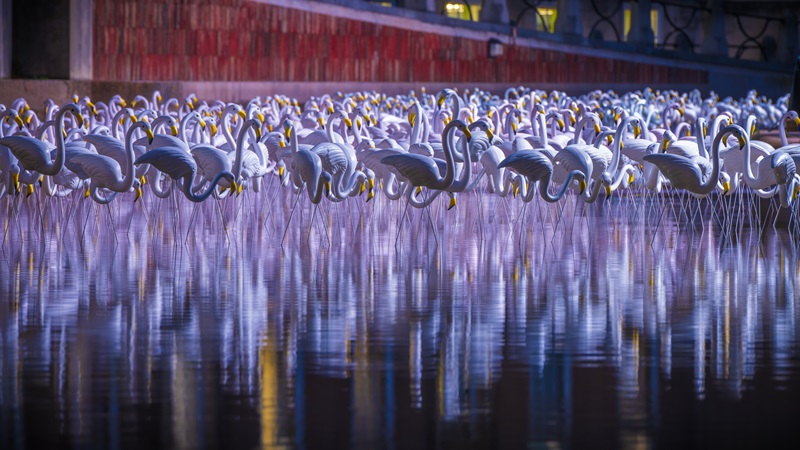
Shrouding the Amphitheatre in a cosmic blend of light and sound, Somnius responds to the audience’s every move, immersing crowds in a playful environment that puts them in control of their experience.
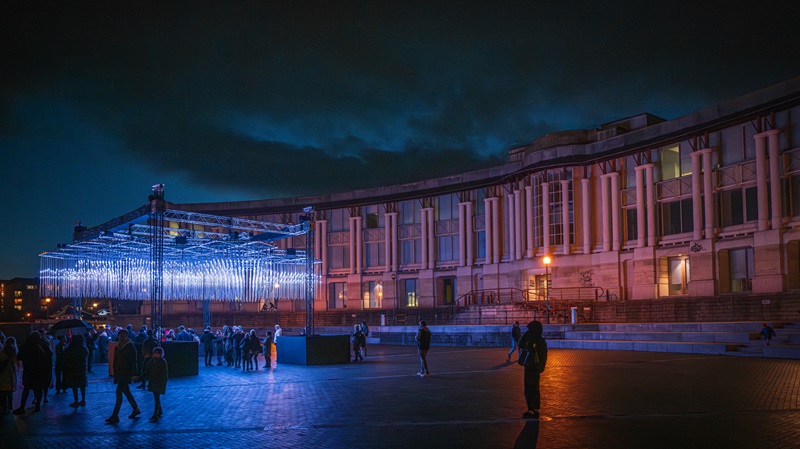
Those crossing Castle Bridge are being painted in reflections of shimmering light as they admire the suspended facade of more than 1,800 recycled CDs and DVDs, inspired by the waters of Sydney Harbour.
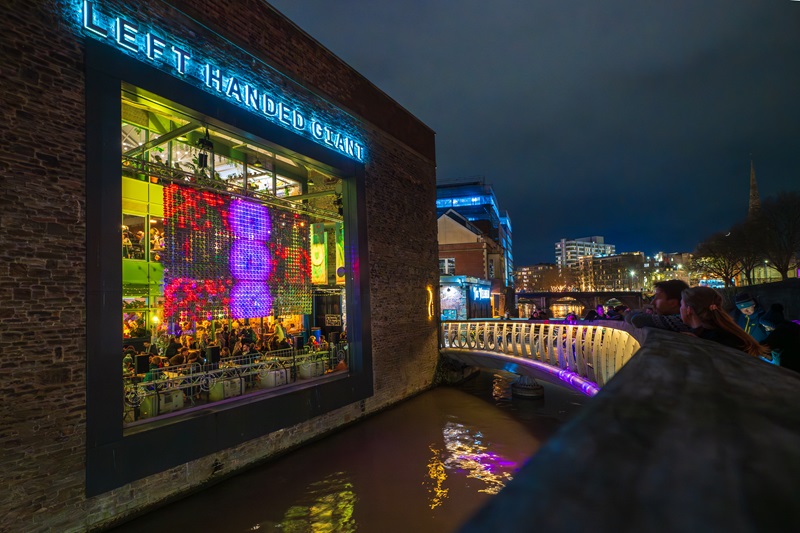
Back for another year of musical delights, Swing Song can be found on Queen Square. Due to popular demand, Bristol Light Festival organisers have introduced a fast track ticket for one set of swings at this year’s event. More information around this, including how to book, is available to view at bristollightfestival.com/swingsong
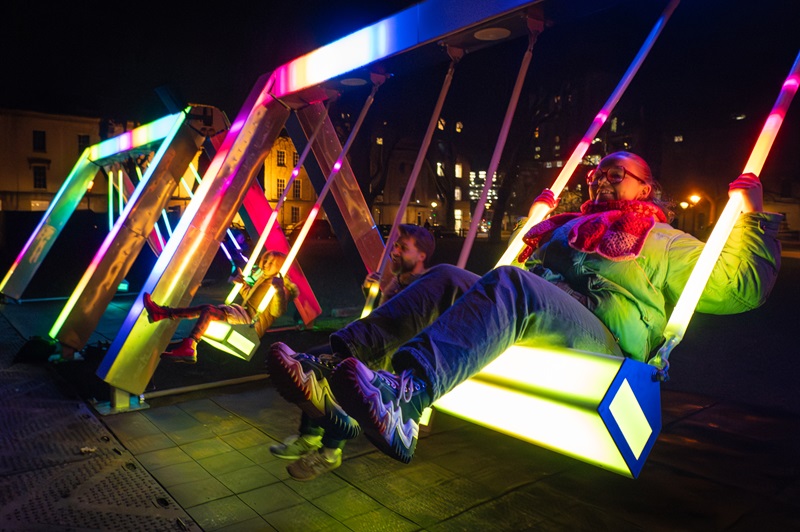
Lighting up the gardens of St Stephens Church is Our Beating Heart, an enormous heart-shaped disco ball that brings people together in its display of shared love.
At Broadmead, visitors to the festival can find Tetra, a tactile installation that needs to be engaged with to truly be felt and understood, taking inspiration from the many forces of nature.

Temple Church has been illuminated into a world of lasers and mirrors, where moving footage of natural phenomena like flora and the cosmos are being transformed into floating abstractions of light with Parallels.

The world premiere of The Whilers can be found in St Mary Redcliffe Gardens, where otherworldly creatures greet visitors as they interact with each other in an awe-inspiring experience.
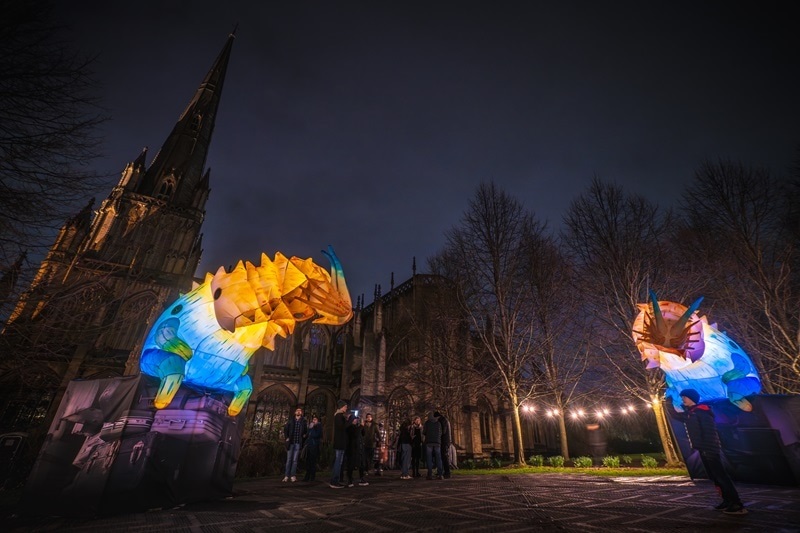
Bringing the history of drum and bass to the centre of Bristol, Anthems: Volume One is inspired by the historic connection between the city and DnB music and can be found at Quakers Friars.

Katherine Jewkes, Creative Director of Bristol Light Festival, said:
“Bristol Light Festival 2025 is underway and it’s amazing to see such a positive response from visitors once again.This year brings such a variety of artworks, but at their core is a real sense of togetherness and connection with audiences. We look forward to seeing what the run holds for visitors and hope that even more people will come to Bristol to see all that is on offer!”
For the current edition of Bristol Light Festival, several Fringe events are happening across the city to allow visitors to amplify their experience.
Photography Walk – Monday 3rd February and Wednesday 5th February, 5:30 – 7pm
Award-winning photographer Adrian Wyatt will be guiding budding photographers around the installations, offering guidance on how to capture the best shots of the installations.
Walking Tours – Monday 3rd, Tuesday 4th, Wednesday 5th and Thursday 6th February, 5:30 – 7pm
An opportunity for festival-goers to orientate themselves within the locations and to learn about the installations. Participants can choose between the ‘waterfront’ or ‘central’ routes, or join an accessible tour.
Official Silent Disco Tour – Wednesday 5th February, 5:30 – 6:30pm, Starting at Bristol Cathedral
On this one hour tour, visitors are invited to boogie their way between art installations accompanied by hit tunes from across the decades. High tech headphones mean that users will be able to hear both the music and their tour guide as they make their way around some of the festival’s highlights.
Neon Kids Rave – Thursday 6th February, 4 – 7pm, Bambalan
The whole family is invited to brighten up February with a non-stop rave party including bright colours and plenty of opportunities to boogie. Tickets can be purchased here
Lights Under the Sea – Saturday 8th February, 10am – 7pm, Bristol Aquarium
To celebrate Bristol Light Festival, the Aquarium will be open later on this date, so visitors can experience the aquarium after dark with its botanical house magically lit with colourful lights. Special UV animal crafts will be available throughout the day, free of charge with an aquarium ticket.
For more information about all events, and to book, visit bristollightfestival.com/events
For the 2025 event, Left Handed Giant has once again created the event’s official beer. This year’s ‘Shining Stars’ is a bright and balanced pale ale, full of citrusy grapefruit and juicy tropical character, from a blend of citra, motueka and el dorado. While visitors check out C-Scales at Castle Bridge, they can grab a can of Shining Stars from Left Handed Giant Brewpub to enjoy the full Bristol Light Festival experience. Shining Stars will also be available at Small Bar, Glassboat and the Royal Navy Volunteer.
Bristol Light Festival’s hub can be found at Queen Square. The perfect place for visitors to meet, regroup and rest, the hub hosts merchandise, including branded beanies, tote bags, light up umbrellas and prints. The hub also houses the information hut, seating and a food market, as well as being the site of two of the festival’s installations – Swing Song and Bristol is Always a Good Idea.
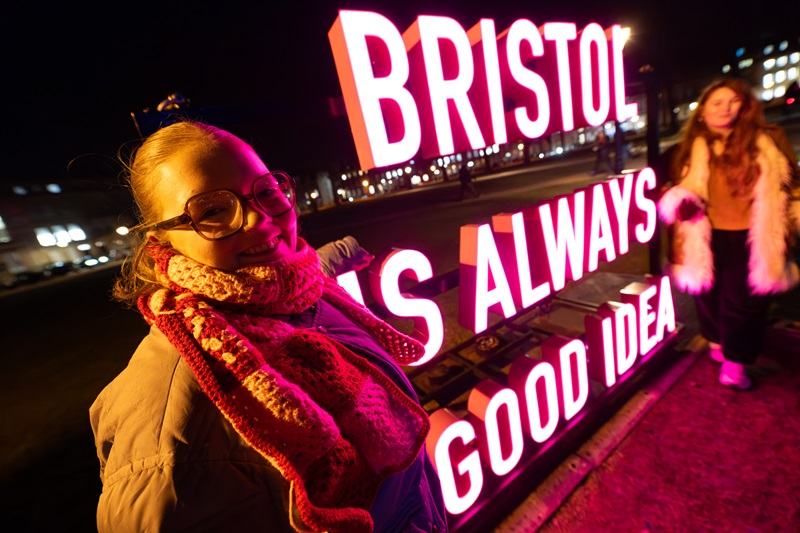
Bristol Light Festival was founded by Bristol City Centre Business Improvement District (BID) and is presented in partnership with Redcliffe & Temple BID. The festival’s Artwork Partners are Broadmead BID and Cabot Circus. Visit Bristol, Visit West’s consumer channel for Bristol, is this year’s media partner. The festival is curated by Katherine Jewkes, Creative Director.
For those looking for somewhere to stay in Bristol City Centre during the festival, a list of offers and discounts for some of the best hotels in the area can be found at bristollightfestival.com/accommodation. The festival recommends booking early to avoid disappointment.
Bristol Light Festival recommends travelling as sustainably as possible. Visitors are encouraged to walk or cycle to the festival where possible, or to utilise the many train and bus options available to the city centre. More information about getting to the festival can be found here: bristollightfestival.com/getting-here/
All information about the festival can be found at bristollightfestival.com
Images credit: Andre Pattenden
This article has previously appeared on the ADLIB Blog.
This article delves into the significance of accessible design, highlighting insights from accessibility specialists and the impact of the upcoming European Accessibility Act.
Accessible design is key in ensuring that websites, services, products and places are inclusive of everyone. But understanding of, and investment into, accessibility and inclusion is not where it needs to be. A 2024 AbilityNet survey found that 19% of respondents considered digital accessibility was a low priority in their organisations, with none of the respondents answering that it was a very high priority. A study by WebAIM found notable increases in accessibility issues across the top 1 million home pages in 2024 – a major problem given around 135 million users across Europe are living with a permanent disability.
Inconsistent senior buy-in, limited budgets, and an uncertain market have been barriers to significant advances in digital accessibility. Considerable improvements are needed across the board to ensure that services, products, places and the web are designed to work for everyone.
si
The European Accessibility Act, which businesses operating in Europe will need to comply with by June, should lead to some improvements in this area in 2025. Additionally, while businesses are sometimes failing to prioritise accessibility, more professionals appear to understand accessibility basics, and despite a slow job market, accessible design skills appear to be in increasing demand. More change is needed, but there are positive signs of improvement going forward.
In 2024, we spoke to individuals working to make the design landscape more inclusive. Through our Design for All interview series, we have heard from accessibility specialists working on products, websites, apps, wayfinding strategies, and written content. These specialists have shared lived experiences of disability and neurodiversity, insights on designing inclusively, and useful resources for anyone looking to improve the accessibility of their designs.
We’d like to express our thanks to all of our contributors this year; Oliver Quinlan, Tom Pinks, Emily Yates, Henny Swan, Cameron Farwell, Rodrigo Sanchez, and Katy Cooper. Here are some of the valuable insights from our contributors.
“Listen, learn, ensure involvement is well-considered and useful (rather than tokenistic) and pay people for their time and expertise. It’s the simplest four-step process that will completely transform how you design but, more importantly, the perspective from which you see the world around you.”
“While guidelines are great, even accessibility guidelines are based on what works for the majority within the disabled community, and they might not account for the full diversity of needs. Designing for the edge cases can lead to solutions that not only benefit the people who need them the most but also improve the experience for everyone.
Take voice interfaces, for example. They were originally designed for people who couldn’t see, but now they’re part of everyday life. The same goes for keyboards and closed captions—designed for specific needs but now used by many people in various contexts. So again, it’s about designing for those edge cases because that’s where you find some fantastic design solutions that positively affect everybody.”
“As a general strategy for accessibility, I’ve always taken a 3-pronged approach with a focus on compliance, culture, and education.
I think of it a bit like the fire triangle they teach you in Science class, where you have oxygen, heat and fuel as the 3 sides, and when you remove one the fire goes out.
In the accessibility triangle, if education is removed, people don’t know how to do accessibility. If culture is removed, people don’t think accessibility is important. And, if compliance is removed, there’s no way to measure whether or not accessibility is being done to the correct standard. Culture is always going to be the hardest to change. Compliance and education are much easier, and in the process you can start to change the culture.”
“Something is better than nothing. If an organisation isn’t as willing to invest in accessibility as much as it ideally should, it’s worth noting that bringing in some elements of accessibility is better than none. Lots of beneficial things can be achieved with fairly low effort and, over time, these small gains will begin to add up. It also makes the potential task of further improvements less daunting when there you aren’t starting from zero.”
The specialists we spoke with have also been kind enough to share recommendations to help make your designs more accessible. We have collected these into a comprehensive Accessible Design Resources List of tools, guides, articles, books, blogs, and videos tailored for specialists at every level – here are our top 3:
We will be continuing the series over this year and can’t wait to share more insights from experts over 2025. If you’re interested in taking part, please contact me at [email protected].
This article has previously appeared on the ADLIB Blog.
Here’s our conversation with Samantha Merrett, Senior Accessibility Specialist at the Ministry of Justice (MoJ).
She shares her journey into accessibility, the role inclusion plays in her work, and how small design changes can make a big impact. Samantha also offers practical advice for designers looking to create more accessible experiences and highlights key resources to stay ahead in inclusive design.
Hi there, my name is Samantha Merrett, and I am a Senior Accessibility Specialist working at the Ministry of Justice (MoJ). I have been at the MoJ for nearly a year now and I have worked in the Civil Service for more than 8 years.
Before joining the team at the MoJ, I was Accessibility Lead at the Food Standards Agency and GOV.UK Managing Editor at the Ministry of Defence (MoD). Whilst working at the MoD, I managed a small team of editors editing and publishing content on GOV.UK. The introduction of the Public Sector Bodies Accessibility Regulations (PSBAR) in 2018 required us to upskill quickly to understand how to ensure our content was accessible.
However, there was one specific moment that made me realise that accessibility was the career for me! I spent time working on the Armed Forces Pension forms to try and make them more user-friendly and accessible. We ran focus groups with users to understand the problem areas and then worked to fix the issues. We then presented the improved forms back to the focus group and the attendees was so thankful that they could now independently claim for their pension.
It was that moment for me that made me realise how important accessibility is. I might have only helped one person in that room but that was enough for me! What we do matters and it can have a profound impact on the users that we serve.
For me accessibility and inclusion go hand in hand, if we make things more accessible, they should be more inclusive for all. In my current role, we encourage all colleagues to consider accessibility from the start, whether you work in design creating digital products or write emails and documents, accessibility should be front and centre.
Adding accessibility in at the beginning makes it much easier to ensure the final product or design is accessible. Addressing accessibility early in the design process is more cost-effective than retrofitting a product later.
Designing for accessibility can lead to innovative solutions that benefit all users. For example, adding captions to videos benefits not only those with hearing impairments but also for users in noisy environments.
Fundamentally, accessible design can enhance usability for everyone not just those with disabilities. This promotes equal access and prevents exclusion.
Promoting inclusive design is a core aspect of my work. I strive to ensure that the information and tools I provide are accessible to everyone. This involves using clear and concise language, offering alternative text for images and ensuring all interactive elements are keyboard accessible. I also never stop learning; I continuously keep up to date with standards and best practices to provide the most relevant and effective support to my colleagues.
One of the main challenges I face is designing visually engaging content whilst making it accessible. I like to ensure that complex topics are explained in an understandable way. Infographics and visuals are often avoided when it comes to accessibility, but this overlooks the benefit they can provide for those who are visual learners or neurodivergent. If graphics are designed using the appropriate colour contrast, accessible font types and use clear and consistent layouts they should be accessible to users. Of course, to make the content accessible you must also provide an appropriate, equivalent text version of the content so users can read through the text if they prefer.
First, you need to understand your users. Take the time to learn about the different ways people with disabilities interact with digital products. This might include using screen readers, keyboard navigation or using voice commands. Talk to people with access needs about their experiences, specifically in the area that you are working in. It is important to truly understand your users and acknowledge that not everyone’s experience is the same. We are all individuals with our own needs and preferences, and we all deserve to have these needs considered.
 Never stop learning and make sure you invest time and energy into your own self-development. Continuous learning helps you to stay up to date with the latest news, technologies and best practices making them more effective in your role. Accessibility is an ever-evolving topic, and it can sometimes feel difficult to keep on top of all the latest trends. If you can prioritise your own development, you not only advance your career but also help to contribute to the overall success and adaptability of your team and organisation.
Never stop learning and make sure you invest time and energy into your own self-development. Continuous learning helps you to stay up to date with the latest news, technologies and best practices making them more effective in your role. Accessibility is an ever-evolving topic, and it can sometimes feel difficult to keep on top of all the latest trends. If you can prioritise your own development, you not only advance your career but also help to contribute to the overall success and adaptability of your team and organisation.
There are so many amazing resources that I could share but these are a couple that I refer to time and time again.
Accessible Design Resources
Following the insightful recommendations from our Design For All participants, we’ve curated an extensive collection of tools, guides, articles, books, blogs, and videos. This resource is specifically designed to support accessibility and inclusion specialists at every stage of their journey.
View Accessible Design Resources
This article has previously appeared on the ADLIB Blog.
As part of the ‘Women in Design’ blog, we spoke with Kirsty Grafton, founder of Graft Creative.
Kirsty discusses balancing family life with running her own business, her passion for meaningful design, and the challenges she’s overcome as a female designer.
I’m Kirsty Grafton, I’ve been working for myself as Graft Creative for the last three years. Before working for myself, I worked at design agencies around Sheffield and Leeds for a decade, and also as an in-house designer for a university for a couple of years.
I initially wanted a career in design because it seemed like a perfect balance of creativity and logic. At school, my favourite subjects were always maths and art – it might seem like an unlikely combination, but I love how design uses creativity to solve problems and create clarity.
I’m a married mum of one, enjoying the challenge of balancing family life with running my business, as well as fitting in as much travel and socialising as possible!
Since going freelance a few years ago I have gradually specialised more and more in working for the charity sector. Typically, I work with medium-sized charities that have limited design capacity in-house. Particularly, I love working collaboratively on their campaign designs, brand development, and bringing to life often quite hefty documents like impact reports. I love working with organisations with heart, making positive change in the world.
I think every woman is a unique being and brings her own experience and knowledge to the table. Some of the most inspiring women I’ve worked with have the attitude of getting cracking with work, being proactive and always pushing things forward. I also really respect any person who is straight-talking but without an ounce of ego or bravado. Someone who can empathise with everyone’s perspective, acting as a true team player by giving everyone in the room a platform to speak.
Your style, preferences and opinions are as valid as anyone else’s. Just because your designs don’t fit into the ‘cool’ box, aren’t the latest ‘trend’, or look a certain way, doesn’t mean they should be discounted. It’s important to stay inspired by external influences, but also to be true to yourself. Keep pushing what you’re doing and trust your gut and opinions.
I found the transition to being a parent in the design industry a particular challenge. I really loved my previous agency role, particularly how sociable it was, but I just couldn’t see how the two worlds of parenting and agency life could comfortably co-exist.
Agency life often means being very responsive to clients’ needs, meaning that work can often land at the last minute, or jobs can take longer than planned. At the agency, my role was full-time – and I was concerned that if I returned part-time to the agency then I might miss out on the meatier projects because of being less responsive. I wanted to ensure I still got to work on creative, rewarding jobs, but respecting my boundaries and parenting balance.
Unfortunately, agencies were not designed to work alongside flexible working when I needed it, and I hope that this is now starting to change with the flexible working bill coming into place.
I would say to anyone in a similar position – remember that you don’t have to stick with the same setup forever. You can go back to work part-time, and then increase your days as your children grow or your situation develops. Don’t worry that your work-life decisions will define you forever. In reality, the period of having a young child or children is relatively short compared to your long working life.
However! Having said that… I think stepping out on my own was one of the best decisions I’ve ever made. I am naturally risk-averse so wouldn’t have made that step unless circumstances forced my hand, but I love the feeling of working with the clients I want to, planning my own time, and being in control of my own business and output.
I’m sure the quote ‘If you can’t see it, you can’t be it’ has been brought up in this series before?! I think having women at all levels in the design industry is important for the next generation of designers to feel it is the right industry for them and that they can make valuable and meaningful contributions.
It’s a shame that over my experience in the design industry, I’ve not worked directly with many women who’ve progressed past management to leadership positions.
Personally, I don’t envision management as being part of my future, but I still think I would have benefitted from being around more women at the entry-level of my career. Agencies would benefit from having more women steering the ship, signalling to young women who are just starting out in the design industry that they will be taken seriously and can aspire to the senior levels in the future.
Sign up to the Women in Design newsletter
If you’re inspired by the stories and wisdom shared in our ‘Women In Design’ series and would like to contribute your own experiences, we’d love to hear from you. Creatives at all levels, please email us and your story could be the next we feature.
You need to load content from reCAPTCHA to submit the form. Please note that doing so will share data with third-party providers.
More Information